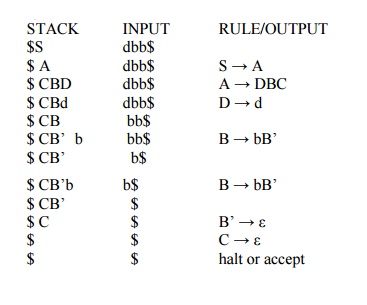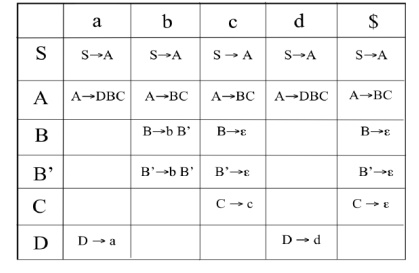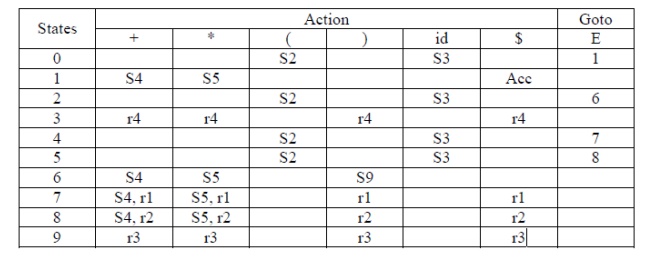Chapter: Principles of Compiler Design : Code optimization
Tutorial problems and worked out examples - Principles of Compiler Design
TUTORIAL PROBLEMS AND
WORKED OUT EXAMPLES
Problem 1
Table-based LL(1) Predictive Top-Down Parsing
Consider the following CFG G = (N={S, A, B, C, D},
T={a,b,c,d}, P, S) where the set of
productions P is given
below: S → A
A → BC | DBC
B → Bb | ε
C → c | ε
D → a | d
a) Is
this grammar suitable to be parsed using the recursive descendent parsing
method? Justify and modify the grammar if needed.
b) Compute
the FIRST and FOLLOW set of non-terminal symbols of the grammar resulting from
your answer in a)
c) Show
the stack contents, the input and the rules used during parsing for the input w
= dbb
d) Construct
the corresponding parsing table using the predictive parsing LL method.
Answers:
a) No because it is left-recursive. You can expand B
using a production with B as the left-most
symbol without
consuming any of the input terminal symbols. To eliminate this left recursion
we add another non-terminal symbol, B’ and productions as follows:
S → A
A → BC | DBC
B → bB’ | ε
B’ → bB’ | ε
C → c | ε
D → a | d
b) FIRST(S) = { a, b,
c, d, ε } FOLLOW(S) = { $ } FIRST(A) = { a, b, c, d, ε } FOLLOW(A) = { $ }
FIRST(B) = { b, ε } FOLLOW(B) = { c, $ } FIRST(B’) = { b, ε } FOLLOW(B’) ={ c,
$ } FIRST(C) = { c, ε } FOLLOW(C) = { $ }
FIRST(D) = { a, d }
FOLLOW(D) = { b, c, $ } Non-terminals A, B, B’, C and S are all nullable.
c) The stack and input are as shown below using the
predictive, table-driven parsing algorithm:

d) The parsing table is as shown below:

Problem 2
Perform left recursion and left
factoring. S → ( )
S
→ a
S → ( A ) A → S
A
→ A , S
Answer
S → ( S’ S → a S’ → ) S’ → A ) A → SA’
A’ → ,SA’ A’ → ε
Problem 3
Eliminate immediate
left recursion for the following grammar E->E+T | T, T->T * F | F, F->
(E) | id.
Answer
The rule to eliminate
the left recursion is A->Aα|β can be converted as A-> βA’ and A’->
αA’|ε. So, the grammar after eliminating left recursion is
E->TE’; E’->+TE’| ε; T->FT’; T’->*FT’ |
ε; F-> (E) | id.
Problem 4
Perform backpatching for the source code:
if a or b then
if c then Answer
x= y+1 After Backpatching:
Translation: 100: if a goto 103
if a go to L1 101: if b goto 103
if b go to L1 102: goto 106
go to L3 103: if c goto 105
L1: if c goto L2 104: goto 106
goto L3 105: x=y+1
L2: x= y+1 106:
L3:
Problem 5
Find the SLR parsing
table for the given grammar and parse the sentence (a+b)*c. E->E+E | E*E |
(E) | id.
Answer
Given grammar:
1. E->E+E
2. E->E*E
3. E->(E)
4. E->id
Augmented grammar
E’->E
E->E+E
E->E*E
E->(E)
E->id
I0: E’->.E
E->.E+E
E->.E*E
E->.(E)
E->.id
I1: goto(I0, E)
E’->E.
E->E.+E
E->E.*E
I2: goto(I0, ()
E->(.E)
E->.E+E
E->.E*E
E->.(E)
E->.id
I3: goto(I0, id)
E->id.
I4: goto(I1, +)
E->E+.E
E->.E+E
E->.E*E
E->.(E)
E->.id
I5: goto(I1, *)
E->E*.E
E->.E+E
E->.E*E
E->.(E)
E->.id
I6: goto(I2, E)
E->(E.)
E->E.+E
E->E.*E
I7: goto(I4, E)
E->E+E.
E->E.+E
E->E.*E
I8: goto(I5, E)
E->E*E.
E->E.+E
E->E.*E goto(I2,
()=I2 goto(I2, id)=I3

Related Topics